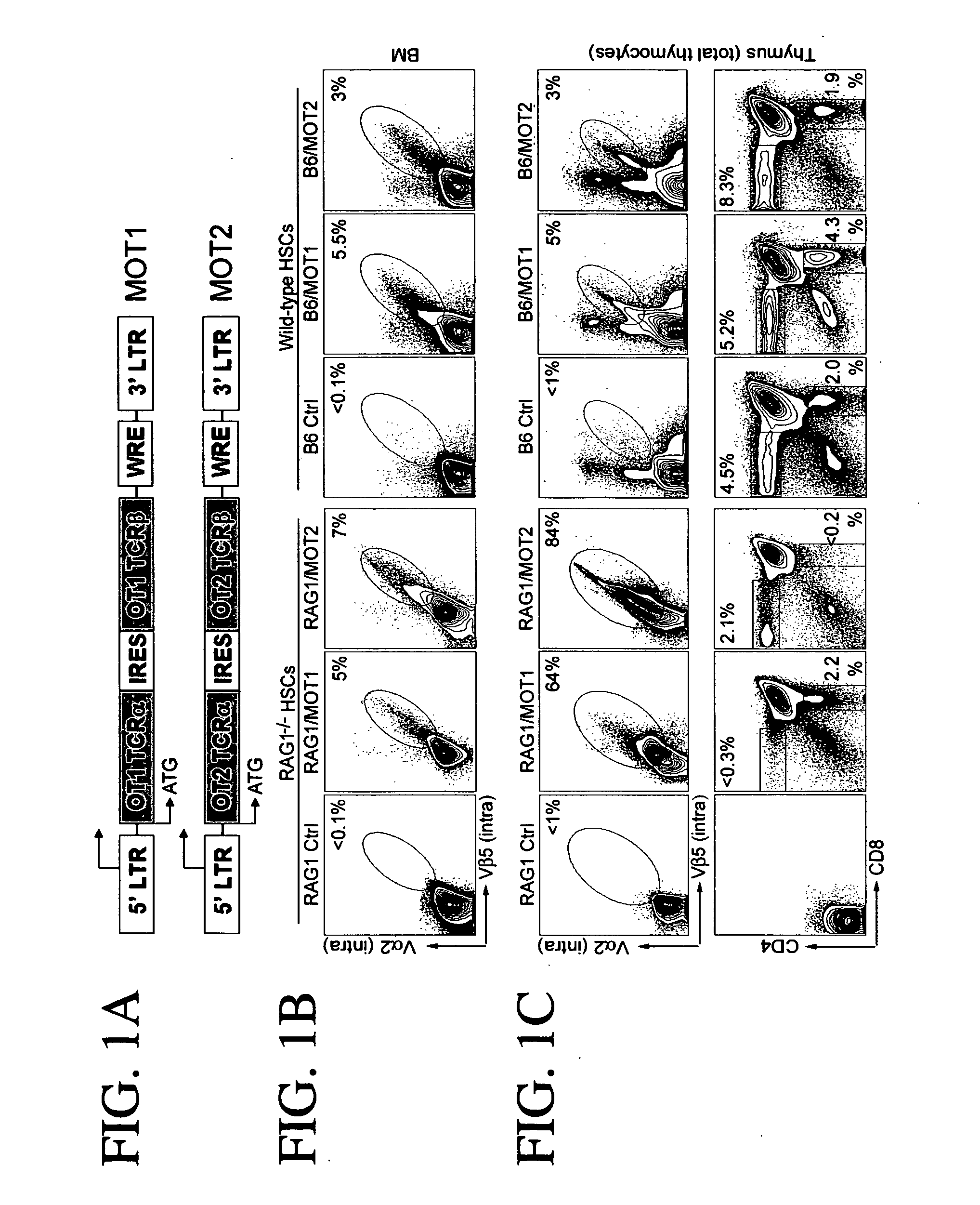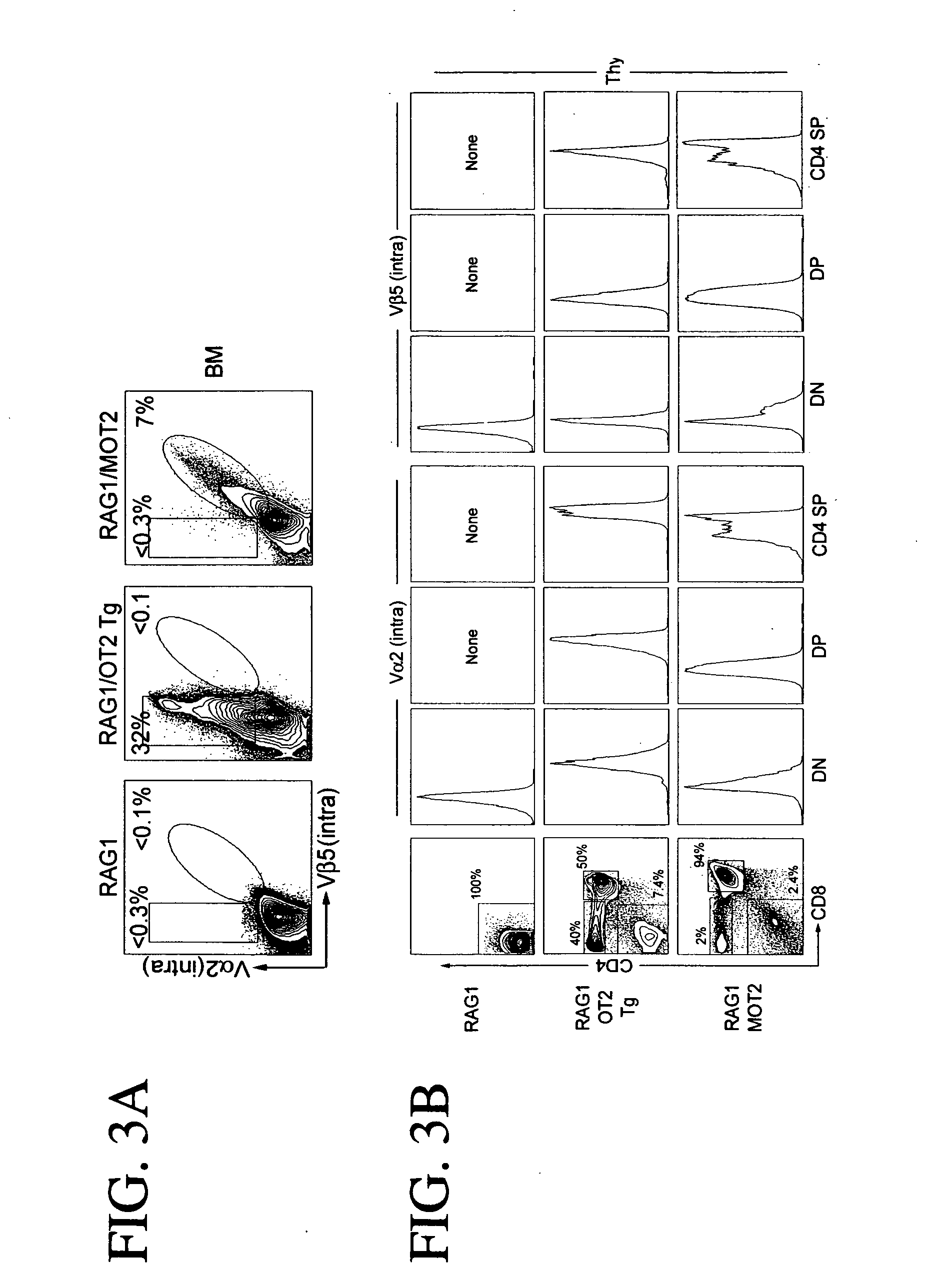Antigen specific T cell therapy
a t cell and specific technology, applied in the field of disease treatment, can solve the problems of poor suppression of tumor growth, immunological failure, and methods that do not produce lymphocytes with specific antigen specificity,
- Summary
- Abstract
- Description
- Claims
- Application Information
AI Technical Summary
Benefits of technology
Problems solved by technology
Method used
Image
Examples
example 1
Functional Expression of CD8 and CD4 T Cell Receptors (T Cell Receptors)
[0177] The OT1 T cell receptor recognizes chicken OVAp257.264 (denoted as OVAp1 herein) and the OT2 T cell receptor recognizes chicken OVAp323-339 (denoted as OVAp2 herein). Both T cell receptors were cloned from B6 mice (Barnden et al. 1998; Kelly et al. 1993). The cDNAs encoding the OT1 or OT2 T cell receptor α and β chains were inserted into a retroviral vector based on MSCV (mouse stem cell virus) under the control of the viral LTR promoter. The resulting constructs were designated as MOT1 and MOT2, respectively (FIG. 1A). To achieve co-expression of the T cell receptor α and β chains, the two cDNAs were linked with an IRES element.
[0178] When MOT1 retroviruses were used to infect activated mouse T cells. OT1 T cell receptors were observed on the cell surface in 41% of the cells, as shown in FIG. 2A, and the infected cells were able to respond to OVAp stimulation to produce the effector cytokine IFN-γ (FIG...
example 2
Generation of Monospecific CD8 and CD4 T Cells by Retrovirus-Mediated Expression of CD8 and CD4 T Cell Receptors
[0179] This example demonstrates that T cell fate is controlled by the nature of the transgenic r cell receptor gene; thus, one can select the type of immune cell to be created based on the origin of the T cell receptor to be expressed. MOT1 and MOT2 constructs were used to generate OT1 CD8 cytotoxic cells and OT2 CD4 T helper cells from wild type hematopoietic stem cells (HSCs) in vivo.
[0180] Antigen-specific T cells were generated in RAG1 deficient (RAG− / −) mice and wild type mice (B6). B6 wild-type and RAG1− / − HSCs were infected with retrovirus generated from a single retroviral vector comprising cDNAs encoding the α and β chains of OT1 (MOT1) or OT2 T cell receptor (MOT2) linked by an internal ribosome entry site (IRES).
[0181] RAG1− / − and B6 mice were treated with 5-FU to enrich the HSCs in bone marrow (BM). Five days later, BM cells were harvested and cultured in v...
example 3
Comparison of the Transgenic T Cell Receptor Expression and T cell Development in Mice Receiving Retrovirus-Transduced RAG1− / − HSCs with Those in the Conventional T Cell Receptor Transgenic Mice
[0188] To evaluate the efficacy of the generation of antigen-specific T cells in vivo, a comparison was made to a conventional transgenic mouse. An OT2 r cell receptor transgenic mouse was previously made by inserting the cDNA encoding the OT2 α chain into a pES4 transgenic expression construct that contained the H-2 Kb promoter, the IgH chain enhancer and the polyadenylation signal sequence of the human β-globin gene. The OT2 β chain gene was inserted into a genomic-based construct (Barnden et al., 1998. Immunol. Cell Biol. 76:34-40).
[0189] A detailed comparison of OT2 T cell receptor expression and T cell development between the RAG1 / MOT2 recipient mice described above and the commercially available OT2 / RAG1 transgenic mice (the conventional OT2 T cell receptor transgenic mice that have b...
PUM
| Property | Measurement | Unit |
|---|---|---|
| diameter | aaaaa | aaaaa |
| β | aaaaa | aaaaa |
| size | aaaaa | aaaaa |
Abstract
Description
Claims
Application Information
 Login to View More
Login to View More - R&D
- Intellectual Property
- Life Sciences
- Materials
- Tech Scout
- Unparalleled Data Quality
- Higher Quality Content
- 60% Fewer Hallucinations
Browse by: Latest US Patents, China's latest patents, Technical Efficacy Thesaurus, Application Domain, Technology Topic, Popular Technical Reports.
© 2025 PatSnap. All rights reserved.Legal|Privacy policy|Modern Slavery Act Transparency Statement|Sitemap|About US| Contact US: help@patsnap.com



